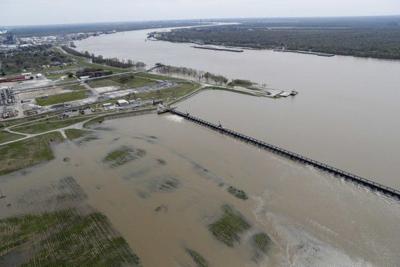Opinion by Steve Cochran
Heavy rain and snow in the Midwest have caused flooding throughout the Mississippi River basin, triggering flood warnings from St. Louis to New Orleans.
Last month, the U.S. Army Corps of Engineers opened the Bonnet Carre Spillway for the 12th time since its construction in 1931 - but the fourth time in just the past decade. And it's possible the spillway may need to be opened again this year, which would be truly historic. When opened, the spillway allows a portion of Mississippi River water, as much as 250,000 cubic feet per second, into nearby Lake Pontchartrain, relieving pressure on downriver levees and preventing catastrophic flooding.
Two weeks ago, an extensive algal bloom developed in the lake, possibly influenced by the opening of the spillway and the influx of nutrient-rich river water into the lake.
These events are yet another reminder of why we need sediment diversions constructed and operated as soon as possible, to help disperse and filter river water through coastal wetlands, rather than sending it into the lake or the Gulf of Mexico, and to take advantage of high-river events to restore our coast.
The water flowing through the river also contains sediment - the kind that built the productive and protective wetlands of coastal Louisiana over thousands of years. Throughout history, as the river flowed through the landscape on its way toward the Gulf, when it flooded, it deposited sediment into the shallow bays and marshes that lay beside the river. Over time this process literally built the Mississippi River Delta, including the land currently occupied by New Orleans and communities across south Louisiana.
Since strengthening of the levees in the 1930s, however, the vast majority of this land-building sediment has remained trapped in the river and is shunted out of the mouth into the deep waters of the Gulf - and into Lake Pontchartrain when Bonnet Carre is open. Either way, it is wasted, and its essential land-building properties ignored.
While Louisiana's coast continues to erode at a rate of one football field every 100 minutes, the resource we so preciously need has continued to flow right past the areas where we need it most.
Louisiana is working hard to change that future. The state is in the midst of implementing its Coastal Master Plan -- the blueprint for coastal restoration and protection efforts. The plan contains more than 100 projects and is updated every five years with the latest science. It's a model for other states facing similar challenges from rising seas, subsiding land and increased storms.
Cornerstones of the plan are sediment diversions, which use the natural power of the river to build land. Strategically placed control structures within the levee system will again allow water and sediment from the Mississippi River into adjacent basins where land loss is occurring. Operated when the river is high - in many ways mimicking the old, natural system - these projects will allow us to manage the river for restoration in conjunction with the levees and spillways that provide flood protection: a win-win.
Using the Mississippi River as a land-building asset will be the difference between staying and leaving for much of south Louisiana. As it has always done, the river will define our very existence here.
Given what we know, why aren't diversions operating now during yet another historic early-spring flood? Why are we allowing the river's nearly 100 million tons of annual sediment to flow past the areas that need it most? Because a sediment diversion hasn't been constructed yet, despite decades of research, planning and modeling.
But the state, with help and cooperation from federal partners, is now moving on the first big sediment diversions. Financing, permitting, engineering, design and construction all take time, as does negotiating the tradeoffs that major landscape changes require. We can argue that these efforts should have been completed decades ago, but here we are.
This time of year in Louisiana, we can actually see our history - and our future, if we don't take action - as it flows past us. Thankfully, we have the knowledge and resources to begin to save our future. That work is now underway, but given the stakes, it can't take a day longer than necessary.
Steve Cochran is director of Restore the Mississippi River Delta and associate vice president for coastal protection at Environmental Defense Fund.

